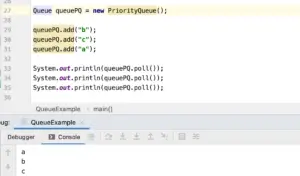
Java is a trademark or registered trademark of Oracle and/or its affiliates in the US and other countries.Ĭopyright © 1993, 2023, Oracle and/or its affiliates, 500 Oracle Parkway, Redwood Shores, CA 94065 USA.Īll rights reserved.
Java queue offer and poll example code#
Parameters: c - the collection to transfer elements into ma圎lements - the maximum number of elements to transfer Returns: the number of elements transferred Throws: UnsupportedOperationException - if addition of elementsįor further API reference and developer documentation see the Java SE Documentation, which contains more detailed, developer-targeted descriptions with conceptual overviews, definitions of terms, workarounds, and working code examples. Modified while the operation is in progress. This queue and adds them to the given collection. Removes at most the given number of available elements from It from being added to the specified collection Queue, or some property of an element of this queue prevents Prevents it from being added to the specified collection NullPointerException - if the specified collection is null IllegalArgumentException - if the specified collection is this Is not supported by the specified collection ClassCastException - if the class of an element of this queue Parameters: c - the collection to transfer elements into Returns: the number of elements transferred Throws: UnsupportedOperationException - if addition of elements This operation is undefined if the specified collection is Attempts to drain a queue to itself result in A failureĮncountered while attempting to add elements toĬollection c may result in elements being in neither,Įither or both collections when the associated exception is This operation may be moreĮfficient than repeatedly polling this queue. Removes all available elements from this queue and adds them Memory consistency effects: As with other concurrentĬollections, actions in a thread prior to placing an object into aĪctions subsequent to the access or removal of that element from } catch (InterruptedException ex) īlockingQueue q = new SomeQueueImplementation() Note that a BlockingQueue can safely be used with multiple Usage example, based on a typical producer-consumer scenario. Interpreted accordingly when taken by consumers. For example, aĬommon tactic is for producers to insert specialĮnd-of-stream or poison objects, that are Such features tend to be implementation-dependent. Indicate that no more items will be added. So it is possible, for example, forĪddAll(c) to fail (throwing an exception) after addingĪ BlockingQueue does not intrinsically supportĪny kind of "close" or "shutdown" operation to Not necessarily performed atomically unless specified Locks or other forms of concurrency control. Queuing methods achieve their effects atomically using internal

Occasional use, such as when a queued message is cancelled.īlockingQueue implementations are thread-safe. Not performed very efficiently, and are intended for only Possible to remove an arbitrary element from a queue using

Primarily for producer-consumer queues, but additionally support

Reports a remaining capacity of Integer.MAX_VALUE.īlockingQueue implementations are designed to be used Time it may have a remainingCapacity beyond which noĪdditional elements can be put without blocking.Ī BlockingQueue without any intrinsic capacity constraints always Null is used as a sentinel value to indicate failure ofĪ BlockingQueue may be capacity bounded. Implementations throw NullPointerException on attempts These methods are summarized in the following table:Ī BlockingQueue does not accept null elements. Null or false, depending on the operation), the thirdīlocks the current thread indefinitely until the operation can succeed,Īnd the fourth blocks for only a given maximum time limit before giving One throws an exception, the second returns a special value (either Of handling operations that cannot be satisfied immediately, but may be The queue to become non-empty when retrieving an element, and waitįor space to become available in the queue when storing an element.īlockingQueue methods come in four forms, with different ways Please do write us if you have any suggestion/comment or come across any error on this page.A Queue that additionally supports operations that wait for Hope you have enjoyed reading Difference between peek poll and remove method of the Queue interface in Java?. Poll = null Exception in thread "main" java.


 0 kommentar(er)
0 kommentar(er)
